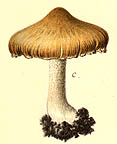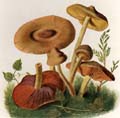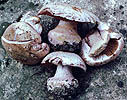Cortinarius traganus
Synonyms
Cortinarius pulchrifolius
Cortinarius lilacinus
Cortinarius pyriodorus
 Key to Gilled Mushrooms Key
Key to Gilled Mushrooms KeyThis is a key to gilled mushrooms, that is, mushrooms having a definite cap with a fertile surface consisting of gills. The fruiting body usually also has a stem, although that may be lateral or absent (usually, then, the mushroom is growing from wood). You can use this key to identify mushrooms that you find.
 Agaricales Order
Agaricales OrderFruiting body containing fibers (usually in the stalk)
 Brown, Olive, Orange or Tan Spored Suborder
Brown, Olive, Orange or Tan Spored SuborderGills not free
Spore print tan, orange, deep ochre, yellowish olive, olive brown, rusty or cinnamon brown or deep brown
Ring usually either absent or not membranous
 Terrestrial Brown Spored Family
Terrestrial Brown Spored FamilyGrowing on the ground
 Cortinarius Genus
Cortinarius GenusWith a cobwebby partial veil called a cortina
Stem often much wider at the base
Spore print usually rusty brown or cinnamon brown
 Sericeocybe Subgenus
Sericeocybe Subgenus
 Mottled Flesh Sericeocybe Section
Mottled Flesh Sericeocybe SectionCap lilac; not intrinsically silvery, but sometimes covered with shiny white hairs from the universal veil
Flesh yellow or pale lilac, mottled with vinaceous, purple, or dark reddish brown streaks
Here are the characters that distinguish this species from the others in its group. For its more general characters, see higher up on the page.
If there's just a few words or a microscopic feature here, a more thorough description can be found above.

Diagnosis
- Cap lilac; not intrinsically silvery, but often covered with shiny white hairs from the universal veil
-
Flesh yellow or pale lilac, mottled with vinaceous, purple, or dark reddish brown streaks
-
Odor pungent and sweet, sometimes compared to overripe pears; or pungent and unpleasant, sometimes compared to goats, burnt hair, or rotting stuff
Microscropic Characters
Comments
Well, I was all set to do a nice big section of Sericeocybe called MottledFleshSericeocybe, but after considerable soul-searching, I have decided to synonymize all its other species with Cortinarius traganus
As far as I can tell from the literature I have, these differ only in odor and subtle shades of flesh color. Spore sizes are the same (or well, well, well within the range of error of different collections and moving between different instruments); the external colors are the same; the size and proportions of the fruiting bodies are the same; call me a lumper, but I just don't see the difference. The shades of flesh color can easily be accounted for by moisture or other environmental conditions (trace elements), and if differences in odor alone justified distinguishing species, we'd also have five different species of Russula laurocerasi
Perhaps someone will come up with a clear way to distinguish these taxa; until then I see to reason to bust my head by trying to perceive and evaluate these "differences", nor, by pretending to distinguish them, to direct you to bust yours






 Key to Gilled Mushrooms Key
Key to Gilled Mushrooms Key Agaricales Order
Agaricales Order Brown, Olive, Orange or Tan Spored Suborder
Brown, Olive, Orange or Tan Spored Suborder Terrestrial Brown Spored Family
Terrestrial Brown Spored Family Sericeocybe Subgenus
Sericeocybe Subgenus Mottled Flesh Sericeocybe Section
Mottled Flesh Sericeocybe Section





